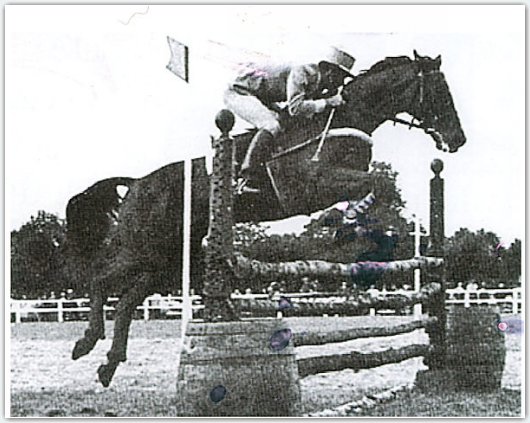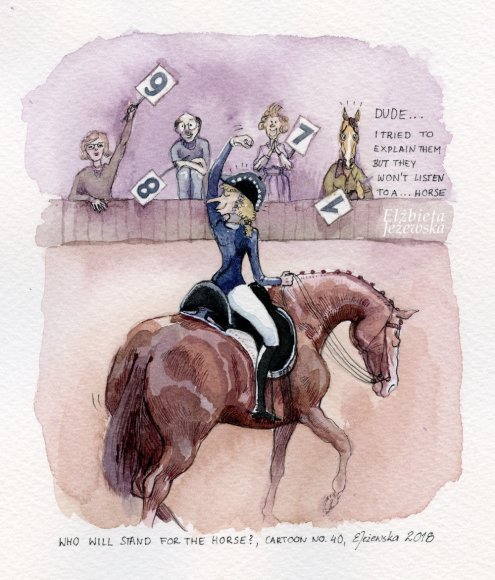Meaning of life 10
The meaning of life 10
Jean Luc Cornille

Quolibet and Jean Luc Cornille during show jumping course at Punchestown 1970

The meaning of life 10
"To know that we know what we know, and to know that we do not know what we do not know, that is true knowledge." (Nicolaus Copernicus)
Returning from an achievement at the 1970 World Championship of Punchestown, everyone at the French Olympic Center of Fontainebleau was smiling; my Horse Quolibet performed better than all expectations. Everyone was very supportive except one man. social media did not exist at this time, but the man came up with a typical social media nasty comment. "So, now you can start to learn how to ride." However, contrary to the social media "keyboard riders," who can't ride, can't train, can't teach but fantasize on their keyboard about a talent they don't have criticizing everybody else, the man was a good rider. Years earlier, he competed with the French Three Day Event Olympic Team at the Mexico Olympics.
I respected the man because he was the type of rider who worked hard for his achievements. I asked him to further his thoughts. "You did well because you took more risks than the others, and your horse kept you alive." I told him, "I agree, but that is what we all do; what is your point?" He cited Copernicus adding that success in the show ring, even at the World Championship, does not necessarily mean knowledge. We both came from the same classical school, but we followed two different paths; he was erudite in equestrian literature, and I was interested in equine science. In his mind, knowledge was the classical literature. In my mind, knowledge was equine biomechanics. In the early seventies, equine science was in its infancy, but there were already pertinent discoveries questioning previous beliefs. He preached absolute devotion to classical authors. With my background as a gymnast, I have experienced in my own body the pain and suffering of not having a physique properly coordinated for the performances' athletic demand. In counterpart, I have also experienced ease and effortlessness executing movements for which my physique was adequately coordinated.
The remark of a pro golfer crossed my mind, "Practice makes permanent." Learning the wrong coordination handicaps both human and equine athletes permanently. Knowledge evolves, and with knowledge, the capacity to efficiently coordinate the horse physique for the performance's athletic demand. By applying pertinent research studies findings, Quolibet raised from being a school horse to a successful world-class champion. He was a school horse because his mind and body revolted against the rigid principles of conventional thinking. Instead of tailoring classical views to the horse's needs, the horse was judged in respect of traditional thinking and downgraded to a school horse's difficult life. He became a world-class champion because I looked out of the box, and the man took umbrage because I had the pertinence to look out of the box. This was forty-seven years ago and, while social media keyboard riders have not evolved one inch, actual knowledge of equine biomechanics has made considerable progress.
Our equestrian discord's primary source was the belief that lowering the neck and engaging the hind legs, shortening the lower line, would flex the upper line. The "bow and string" concept has been created decades earlier, in 1946, by Dutch scientist. E. J. Slijper. "The horse has a very flat-shaped bow which is made up of the vertebral column, its epaxial muscles, and ligaments. The whole structure is kept rigid and under tension from the string formed by the sternum, abdominal muscles, linea alba, and the muscles of the limbs." (E. J. Slijper, 1946). My opponent believed that the "core" was responsible for all vertebral column movements. I questioned the thought because it did not fit the tremendous diversity of complex and minuscule movements that the horse back executed during locomotion and performance. Richard Tucker's dynamic study better explained the wide variety, complexity and precision of the back movements. "An initial thrust on the column is translated into a series of predominantly vertical and horizontal forces which diminish progressively as they pass from one vertebra to the next." (Richard Tucker-1964). The thought that the back muscles were capable of converting the thrust generated by the hind legs into upward forces, balance control, horizontal forces, forward movements, and other forces involved in lateral bending and inverted rotation was more in line with the feeling given by the horse back during work and performance.
The Mexico Olympics' cross-country course was altered by an enormous storm that let the ground saturated with water. The flooding running through the water jump was so deep and so intense that a few horses had to be rescued from drowning. The man had the bad luck of completing the course after the storm. He described the incredible contortions of his horse's back trying to climb the bank out of the water with a footing so slippery that even with studs on the shoes, the front legs were unable to have any grip. I commented, "It does not make sense that large muscles situated below the sternum and muscles such as the rectus abdominis, which have a relatively simple structure, could create such complex throracolumbar column movements. While pectoral and abdominal muscles are likely involved in thoracolumbar spine flexion, bending, and extension, the thought that epaxial and hypaxial muscles of the thoracolumbar column are the ones creating vertebral column movements is more in line with what we can feel and observe preparing horses for athletic performances." As the man remained silent. I reminded him that the cranial thoracic vertebrae have twelve articular surfaces. The vertebrae are constructed this way because a large diversity of minuscule movements occur. It is more likely that these microscopic movements are orchestrated by muscles inserted on and around the vertebrae than massive pectoral muscles situate below and around the sternum. The man's mind was spinning for an answer, but he was cornered and pulled out the classical umbrella; "Thousand years of tradition cannot be wrong." I was ready to oppose that thousand years of tradition have defended the thought that the earth was flat, but in the seventies and today, members of the flat earth society were, and still are, unable to evolve.
However, one week later, the man came back saying, "I did not know that you were doing some research. What you told me about the back muscles turned in my mind, and it fits what I have always felt." The man was indeed a horse person. His anger against high competition was not directed against me but against the training techniques' incapacity to fully prepare the horses for the athletic demand of modern performances. He was frustrated because the equestrian literature does not provide solutions. He was hostile initially because I was, in his mind, another rider ready to take the risk and challenging the horse beyond the horse's athletic capacities. He was judging what I was doing from the limits of his world. Paraphrasing James Rooney, the man's view was restricted by his teleological thinking. "The waspish ghost of teleological thinking constantly cloud the picture." (James Rooney, Biomechanics of lameness in horses, 1976)
Exploring the thought that back muscles have the capacity to convert the trust generated by the hind legs into horizontal forces, upward forces, and other movements such as lateral bending and associated rotation implied upgrading riding and training principles to the way the back muscles are designed to function. Classic authors promoted shifting the rider's weight, "Undoubtedly any shift of the rider's weight is important for balancing the horse for controlled movements." (Estienne Saurel. !964. Pratique de l’équitation d’après les maitres français. Flammarion, Paris) The same year, Richard Tucker explained that the main back muscles were set and working in the opposite direction. In the light of Tucker's explanation, any shift of the rider's weight can only alter the horse's ability to coordinate the back muscles properly. The first aim was finding the way to sustain a neutral balance, a balance over the seat bones where the bodyweight would not be acting front to back or back to front. The problem is that every weekend I was in the show ring, and judges give a score concerning what they believe and not what new scientific findings suggest.
"There is another world, but it is in this one." (William Butler Yeats) I was gradually using my body differently, but the look was about the same. I was exploring another world, but it looked like this one. Some judges could not see beyond their teleological thinking, scoring me down on the rider's position because I was not on my gluts leaning backward. Better judges regarded the harmony with the horses liking the suspension and cadence. One judge, who had a great sense of humor, loved the horse's gaits so much that he gave me 11 on the rider position. Typically, the score is from 0 to 10.
Updating riding techniques to actual understanding of equine thoracolumbar spine biomechanics makes it possible to achieve subtle orchestration of the work of the back muscles and, consequently, improve or modify limb kinematics. Poor mover became good movers, and good movers became great movers. The same technique allows correcting limb kinematics abnormalities causing injury. James Rooney's "Biomechanics of lameness in horses" can now become the biomechanics of soundness. The missing link was the capacity to correct the limb kinematics abnormality. Both conventional and veterinary thinking regarded back problems as a consequence of hocks or other limb issues. The thought that back kinematics were controlled by abdominal and pectoral muscles only permitted approximative coordination of the back muscles. The capacity to correct limb kinematics abnormalities through sophisticated coordination of the thoracolumbar column was not possible.
We name the approach Motion Microscope Therapy because the therapy is done entirely in motion. The therapy is about identifying and correcting the source of aberrant limb kinematics causing injury. In most instances, the root cause in thoracolumbar column dysfunction and correcting the dysfunction demand the sophisticated education and coordination of numerous but microscopic movements. The proper motion requires looking at the horse locomotion under the eye of a microscope. Jean Luc Cornille


 twitter
twitter facebook
facebook google
google stumbleupon
stumbleupon pinterest
pinterest linkedin
linkedin